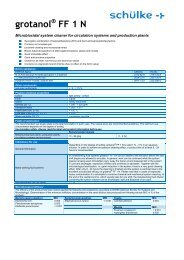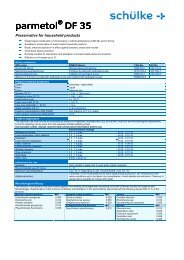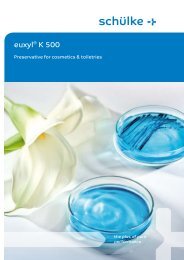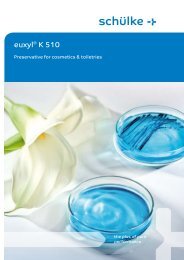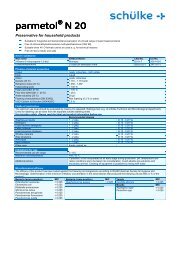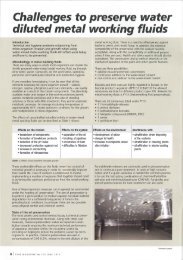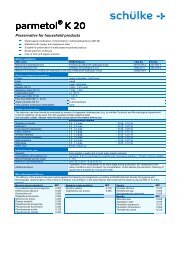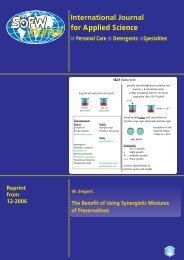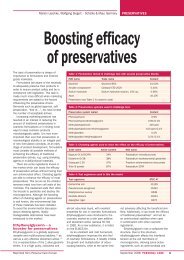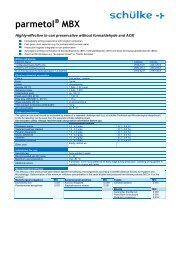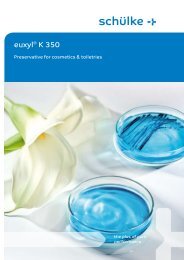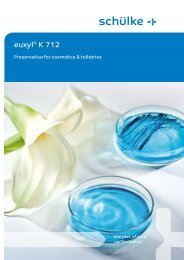A New Concept to Boost the Preservative Efficacy ... - Schülke & Mayr
A New Concept to Boost the Preservative Efficacy ... - Schülke & Mayr
A New Concept to Boost the Preservative Efficacy ... - Schülke & Mayr
Create successful ePaper yourself
Turn your PDF publications into a flip-book with our unique Google optimized e-Paper software.
COSMETICSPRESERVATIVESThe maximum allowed concentrationaccording <strong>to</strong> EU Cosmetic Directive is1.1%, due <strong>to</strong> <strong>the</strong> limit of 1.0% for phenoxyethanol.At <strong>the</strong> recommended useconcentrationof 0.5 <strong>to</strong> 1.0% Euxyl® PE9010 is soluble in most cosmetic formulations.The low surface tension ofEuxyl® PE 9010 solutions assures gooddispersion in various systems, even atlow temperature.As phenoxyethanol and ethylhexylglycerinare alcohols, <strong>the</strong> product isstable <strong>to</strong> hydrolysis, <strong>to</strong> higher temperatures(e.g. 100 °C) and <strong>to</strong> low as well ashigh (pH 2 - 12) pH values. Fur<strong>the</strong>rmore,it remains liquid with a moderate viscosityat temperatures as low as -20 °C.In general, Euxyl® PE 9010 displays goodcompatibility with o<strong>the</strong>r cosmetic ingredients.No discolourations have been detected.The product shows no interactionswith sulphite ions or with pigmentslike TiO 2. It can <strong>to</strong>lerate high salt content.Cationic and amphoteric substances donot adversely affect <strong>the</strong> preservative activity.However, it is yet not recommendedfor formulations containing comparativelyhigh amounts of ethoxylated surfactantsbecause <strong>the</strong>se surfactants areable <strong>to</strong> neutralise <strong>the</strong> boosting activityof ethylhexylglycerin.Due <strong>to</strong> its high solvency, Euxyl® PE 9010can serve as a solvent for lipophilic additiveslike perfumes, vitamins and essentialoils. Formulas containing naturalraw materials are particularly susceptible<strong>to</strong> microbial growth. Fast-actingEuxyl® PE 9010 can eliminate microorganismsquickly, making it more effectivethan slower acting preservatives.Designed as a substitute for parabencontainingpreservative systems, it alsooffers an alternative <strong>to</strong> formaldehydereleasersand isothiazolinones. Its use isrecommended in leave-on preparations,such as lotions, creams, sun care products,transparent gels and o<strong>the</strong>rs, as wellas cosmetic wet wipes. Microbiological efficacyEuxyl® PE 9010 is equally effective againstbacteria, yeasts and fungi. It is effectivewithin a broad pH range, up <strong>to</strong> pH 12. Itshows higher activity, e.g. in preservativeefficacy tests (S&M KoKo test) (8,9) or ingerm count reduction tests, comparedSpecies ATCC- Euxyl® PE 9010 Phenoxy-Nr.: [%] ethanol [%]Gram-negative:Enterobacter gergoviae 33028 0.5 0.5Escherichia coli 11229 0.5 0.5Klebsiella pneumoniae 4352 0.25 0.5Pseudomonas aeruginosa 15442 0.5 0.5Pseudomonas fluorescens 17397 0.25 0.5Pseudomonas putida 12633 0.5 0.5Gram-positive:Staphylococcus aureus 6538 0.5 1.0Staphylococcus epidermidis 12228 0.5 1.0Mould fungi:Aspergillus niger 6275 0.25 0.5Penicillium funiculosum 36839 0.25 0.25Yeast:Candida albicans 10231 0.25 0.5Table 2 MIC values (dilution test) of Euxyl® PE 9010 compared <strong>to</strong> phenoxyethanolagainst different microorganismswith phenoxyethanol and ethylhexylglycerinindividually. The efficacy can beillustrated by <strong>the</strong> determination of<strong>the</strong> Minimum Inhibi<strong>to</strong>ry Concentration(MIC) values and by performing germcount reduction tests.MIC valuesTo compare <strong>the</strong> MIC values of Euxyl® PE9010 with phenoxyethanol, <strong>the</strong> minimuminhibi<strong>to</strong>ry concentration againstdifferent microorganisms in a serial dilutiontest was determined (Table 2).While ethylhexylglycerin alone has noappreciable effect on microorganisms,<strong>the</strong> enhanced phenoxyethanol in Euxyl®PE 9010 is proven <strong>to</strong> have better efficacyagainst many microorganisms thanphenoxyethanol alone.Germ count reduction testTo show <strong>the</strong> effect of ethylhexylglycerinon <strong>the</strong> performance of phenoxyethanolas a preservative, germ count reductiontests on Pseudomonas aeruginosa (ATCCno. 15442) and Aspergillus niger (ATCCno. 6275) were performed with dilutionsof Euxyl® PE 9010 in sterile tap waterand compared <strong>to</strong> <strong>the</strong> single components.Fifty-ml portions of <strong>the</strong> end solutions areeach inoculated with 0.5 ml microorganismsuspension and stirred. The initialmicroorganism count of <strong>the</strong> test solutionsis approximately 10 8 cfu/ml.These solutions are streaked out on<strong>to</strong>tryp<strong>to</strong>ne soya agar (Pseudomonas aeruginosa)or sabouraud-dextrose 4.0% agar(Aspergillus niger) after 3, 6, 24, 48, 72and 168 hours depending on <strong>the</strong> test organism.The cultures are incubated for48 hours at 37 °C or 72 hours at 25 -27 °C.The evaluation is made on <strong>the</strong> basis ofsemi-quantitative assessment of <strong>the</strong> microbialgrowth of <strong>the</strong> streaks.As Fig. 3 clearly demonstrate, ethylhexylglycerin,without having any efficacyagainst Pseudomonas aeruginosa or Aspergillusniger alone (green line), boosts<strong>the</strong> efficacy of phenoxyethanol as <strong>the</strong>preservative active in Euxyl® PE 9010 (blueline) compared <strong>to</strong> phenoxyethanol alone(red line). The improved efficacy of <strong>the</strong>combination can be seen after a shortperiod of time.4 SÖFW-Journal | 131 | 11-2005
COSMETICSPRESERVATIVES Mode of actionEthylhexylglycerin has a chemical structurecomparable <strong>to</strong> surfactants. A calculatedHLB-value of 7.4 means that it belongs<strong>to</strong> <strong>the</strong> group of wetting agents orwater-in-oil emulsifiers. It is able <strong>to</strong> reduce<strong>the</strong> surface tension of water significantly(Fig. 4a).In combination with phenoxyethanol inEuxyl® PE 9010 an additional reductionof <strong>the</strong> surface tension can be observed.For a 1.0% solution of Euxyl® PE 9010 inwater <strong>the</strong> surface tension is 32.1 mN/m(water: 72.6 mN/m). This is even lowerthan <strong>the</strong> surface tension of 0.1% ethylhexylglycerin,as <strong>the</strong> contact angles of<strong>the</strong> corresponding water drops on materialslike polyethylene clearly demonstrate(Fig. 4b).Although Euxyl® PE 9010 significantly reduces<strong>the</strong> interfacial tension in a foamingtest according <strong>to</strong> DIN 53 902, a 1.0% solutionin demineralised water proved <strong>to</strong>be non-foaming.It is postulated that <strong>the</strong> addition of ethylhexylglycerinaffects <strong>the</strong> interfacial tensionat <strong>the</strong> cell membrane of microorganisms.This improves <strong>the</strong> contact ofphenoxyethanol with <strong>the</strong> cell membraneresulting in a better interaction of phenoxyethanolat <strong>the</strong> cell membrane andan improved antimicrobial efficacy.Fig. 3 Germ count reduction in tap water achieved by Euxyl® PE 9010 compared<strong>to</strong> <strong>the</strong> single components against Pseudomonas aeruginosa and Aspergillus niger Practical experienceThe effectiveness of this system in cosmeticformulations has been tested in<strong>the</strong> S&M KoKo test. This is a multiple-inoculation,preservative efficacy test designedand validated by Schülke & <strong>Mayr</strong>.A mixed suspension of Gram-positive andGram-negative bacteria, yeast and mouldis used for inoculation. At weekly intervals,a sample of <strong>the</strong> test product isstreaked out on<strong>to</strong> nutrient media, incubatedand evaluated semi-quantitatively.The longer <strong>the</strong> time before <strong>the</strong> occurrenceof <strong>the</strong> first microbial growth, <strong>the</strong>more effective <strong>the</strong> preservative. Experiencehas shown that a well-preservedproduct should remain growth-free for4a4bFig. 4a Surface tension [mN/m] of 1.0% Euxyl® PE 9010 in water compared <strong>to</strong> 0.9% phenoxyethanol, 0.1% ethylhexylglycerinand water as well as 4b <strong>the</strong> corresponding water drops on a polyethylene surfaceSÖFW-Journal | 131 | 11-2005 5
COSMETICSPRESERVATIVESsix inoculation cycles <strong>to</strong> ensure <strong>the</strong> shelfliferequired in practice (30 months in<strong>the</strong> original packaging).Oil-in-water and water-in-oil systemspreserved with use-concentrations ofbetween 0.5 and 1.0% Euxyl® PE 9010proved <strong>to</strong> be well preserved even afterthree months s<strong>to</strong>rage at +40 °C.Fig. 5 shows <strong>the</strong> result of <strong>the</strong> S&M KoKotest on a Moisturizing Soothing Balmpreserved with 1.0% Euxyl® PE 9010, aswell as with <strong>the</strong> single components.Only <strong>the</strong> sample preserved with 1.0%Euxyl® PE 9010 was proved <strong>to</strong> be wellpreserved after 6 inoculation cycles,while 0.9% phenoxyethanol as well as0.1% ethylhexylglycerin were ineffective.Whereas ethylhexylglycerin alone has noand phenoxyethanol alone shows nosufficient efficacy against microorganisms<strong>the</strong> enhanced phenoxyethanol inEuxyl® PE 9010 is proven <strong>to</strong> preserve thisMoisturizing Soothing Balm very well.In rinse-off products containing highamounts ethoxylated surfactants <strong>the</strong>product is yet not recommended because<strong>the</strong>se surfactants are able <strong>to</strong> neutralise<strong>the</strong> boosting activity of ethylhexylglycerin.As <strong>the</strong> interest is high in usingEuxyl® PE 9010 also in rinse-off productsefforts were made <strong>to</strong> decrease <strong>the</strong> loss ofefficacy by adding complexing agents. Inaqueous surfactant solutions (10% a. i.)germ count reduction tests of <strong>the</strong> combinationof complexing agents withEuxyl® PE 9010 gave better results thanalone. Fig. 6 shows how 0.05% EDTAand 1.0% Euxyl® PE 9010 can reduceFig. 5 Result of preservative efficacy test on <strong>the</strong> Moisturizing Soothing Balmduring 6 inoculation cyclesFig. 6 Germ count reduction test in ethoxylated surfactant solutions againstPseudomonas aeruginosa in <strong>the</strong> presence of complexing agentsFig. 7 Carbomer gels, gel 1: unpreserved; gel2: preserved with 1.0% Euxyl® PE 9010; gel 3:preserved with 1.0% of a standard parabenmixture in phenoxyethanolPseudomonas aeruginosa also in frequentlyused ethoxylated surfactant solutions.These results may encourage formula<strong>to</strong>rs<strong>to</strong> check if <strong>the</strong> combination of Euxyl® PE9010 with complexing agents can successfullypreserve surfactant based rinseoffproducts. At this early stage of experienceit is strongly recommended <strong>to</strong> check<strong>the</strong> individual finished product as <strong>the</strong> efficacymight depend on <strong>the</strong> particularformulation.Fur<strong>the</strong>rmore Euxyl® PE 9010 is ideal for<strong>the</strong> preservation of clear, transparent gels.As Fig. 7 shows, gels preserved with <strong>the</strong>product (gel 2) stay clear and transparentcompared <strong>to</strong> a standard parabenmixture in phenoxyethanol (gel 3). ConclusionEuxyl® PE 9010 is an answer <strong>to</strong> <strong>the</strong> personalcare industry’s increasing demandsfor new preservation concepts. It is anbroad-spectrum preservative based onphenoxyethanol in combination with <strong>the</strong>multifunctional ethylhexylglycerin. The6 SÖFW-Journal | 131 | 11-2005
COSMETICSPRESERVATIVESaddition of ethylhexylglycerin affects <strong>the</strong>interfacial tension at <strong>the</strong> cell membraneof microorganisms, improving <strong>the</strong> preservationactivity of phenoxyethanol impressively.It is is a patented liquid concentratewith extensive <strong>to</strong>xicological dataon its ingredients. Its physical andchemical properties, as well as its microbiologicalefficacy, make Euxyl® PE 9010ideal for <strong>the</strong> formulation of skin careproducts. It is focused for leave-on productsand ideal for <strong>the</strong> preservation ofclear, transparent gels. This new preservativesystem is a reasonable alternative<strong>to</strong> classical preservation blends.Literature(1) The Merck Index, Thirteenth Ed., Monograph Nr.7341(2) H. P. Fiedler, Lexikon der Hilfss<strong>to</strong>ffe für Pharmazie,Kosmetik und angrenzenden Gebiete,Editio Verlag Aulendorf, 5. Aufl., 2002, 1305 –1306(3) Hagers Handbuch der pharmazeutischen Praxis,Springer-Verlag Berlin, 5. Auflage, Folgeband 5,1999, 425 – 426(4) H. Eggensperger, Multiaktive Wirks<strong>to</strong>ffe fürKosmetika, Verlag für chemische Industrie H.Ziolkowsky GmbH Augsburg, 1995, 141 – 159(5) W. Beilfuß, W. Siegert, Cossma, 2003, 6, 54 – 55(6) W. Beilfuß, SÖFW Journal, 1998, 6, 360 – 366(German edition)(7) H. M. Fishman, Happi, 2005, Vol. 42, No. 2, part1 of 2, 35(8) K. Weber, J. Siebert, SÖFW-Journal, 2003, 6, 44 –50 (English); 48 – 55 (German edition)(9) W. Siegert, Cosmetic Science Technology, 2005,189 – 195.* Authors’ address:Dr. Wolfgang BeilfussDr. Marion LeschkeDr. Klaus WeberSchülke & <strong>Mayr</strong> GmbH22840 NorderstedtGermanyEmail: sai@schuelke-mayr.comSÖFW-Journal | 131 | 11-2005 7




